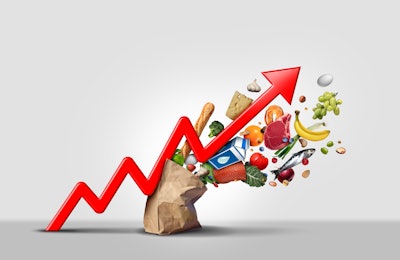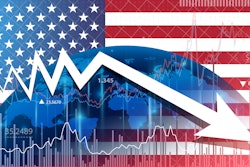
It seems longer than a year ago that the biggest threat to restaurants and retail traffic was COVID-19 safety concerns. With 2022 nearly at a close, COVID-19 has taken a back seat to many other economic factors, namely supply chain issues, labor shortages, and most notably, inflation.
Medallia Market Research conducted several studies to understand the role inflation plays in consumer decision making.
Inflation: The biggest factor in the minds of consumers
When asking U.S. households what factors have affected their purchase decisions the most over the past three months, “Changes to the price of products” ranks in a clear top spot out of 15 choices, including things like paying down debt and unforeseen spending needs. It was most recently cited by 49% of respondents, which is a massive jump compared to the only 29% of respondents citing it in August 2021.
Other factors top of mind within the food and beverage industry, like “changes in amount of staff/serve level at retailers or restaurants” or “change in government policies regarding COVID-19” do not rank in the Top 8 and are each cited by under 7% of respondents. It is evident that inflation is playing a particularly large role in the minds of consumers, and food retailers can’t presume large price increases will be met with full shopper acceptance.
Consumers say they’re cutting food purchases more than other products like gasoline
Consumers generally have three approaches to dealing with inflation - cutting expenses, finding sources of more income or using savings/taking on debt. While many indicate a mix of the three, the most common is in cutting expenses. Trading down to cheaper products or buying fewer of them was cited as the most common approach (42%), with cutting back on restaurants (37%) and on travel and leisure (28%) following behind.
As far as where consumers are cutting back purchases, restaurants rank higher than many other product categories like household goods and gasoline. This is also validated by smartphone foot traffic data, which shows visit volumes to convenience stores (a proxy for the volume of gas fill-ups) has trended steadily over the past year, occupying more market share within the retail industry now than it did in 2019. With some things nearly impossible to avoid purchasing despite the price, the “need-to-have” categories are cited as being purchased with the same frequency as before more than some “nice to have” ones like travel, electronics, entertainment and apparel.
There hasn’t been a “share of stomach” disruption for restaurants vs. grocery stores
In analyzing the spend behavior of over 5 million credit and debit card panelists and comparing 2022 to 2019 baseline levels, both restaurants and grocery-focused retailers (e.g. categories like club, supermarket, mass, dollar, etc.) have seen a modest decline in transaction volume following a post-COVID-19 recovery period in 2021. Although most categories have offset these declines with large increases in dollars per transaction (primarily price-driven), restaurants and retailers are not faring any better than simply treading water. Interestingly, despite consumers cutting back on unnecessary expenses, restaurant transaction volume has not suffered noticeably worse trends than grocery retail has.
In an environment where consumers would be expected to source each meal for a few dollars as possible, how could this be? Consumers continue to cite the convenience and speed factors of restaurants as compelling reasons to choose them, and many may also be deterred from supermarkets due to grocery prices rising faster than restaurant prices over the past year.
What may also be helping restaurants is the ability to soften the blow of inflation by pulling levers beyond price increases alone. Medallia’s research shows that slightly more than half of consumers would prefer brands adapt to inflation by incorporating a mix of modest price increases with slight reductions in service, product size or product quality (as opposed to solely increasing price at or above the full inflation rate). Less than 20% prefer a higher price increase without any product or service cutbacks. The restaurant model was one that allowed more wiggle room and product control than that of a grocery store, which already had thin margins, fewer employees to serve each customer, and product characteristics more in the hands of external manufacturers. Thus, it may have been inevitable for grocery stores to increase prices at a higher rate than restaurants did.
Not all restaurants are experiencing stagnant market share trends, however. The more affluent household income brackets, namely all of those above $80,000 per year, have increased their spend at limited service (e.g. quick-service, fast casual) chains faster than at full-service dining establishments, and are also sustaininq limited service restaurant spend trends over 10 percentage points higher than lower income groups. It appears some “trade down” behavior is occurring from full service to the cheaper limited service alternatives among this group, but also important to note full service chains collectively are still in much better shape than in 2020 and much of 2021.
The future outlook for food retail isn’t overly dire, but there are warning signs to monitor
Nearly all consumers say another 5 percentage point increase in the inflation rate would be met with drastic changes to their shopping decisions. It’s no surprise, since only 23% of consumers now say they’re able to cover all of their bills and meet or exceed their goal savings amount (vs. 31% in August 2021). Fortunately, the acceleration of the inflation rate has been less severe in recent months. Daily polls of Medallia Market Research panelists show that factors like the “price of products” has not further increased as a driver of household purchase decisions, though it still ranks No. 1.
The biggest warning sign to monitor is that while the most common consumers want to deal with inflation by reducing expenditures, a sizeable 37% of the population says at least one of their approaches involves using up savings or taking on loans they have not yet begun to pay off. If inflation does climb or if the problem drags on long enough, these solutions may become unsustainable and further cutbacks on consumption could occur.
With a complex environment ahead, unknowns about the inflation rate and the impact changing interest rates could have on employment and purchasing power, the best thing retail and restaurant leaders can do is keep a close pulse on how consumers are behaving. The stakes are too high, and market conditions too zero-sum, to be forming strategies without an understanding of competitor performance or the sentiments of consumers.



















